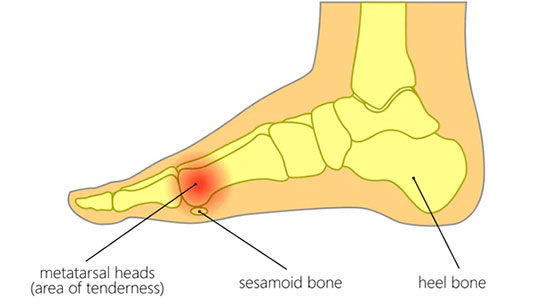Metatarsalgia
Metatarsalgia is a common foot condition where the Metatarsal bones, which connect your arch to your toes, become sore from injury or overuse and the area around them becomes inflamed. This causes pain in the ball of your foot generally located near your big toe.
WHAT CAUSES METATARSALGIA?
- High-impact sports
- Overuse
- Excessive Pronation
- Hammertoe
- Stress Fractures
- Age. The pads in feet become thinner over time and do not offer as much protection over time.
- Poorly fitting shoes such as shoes that are too tight or lack support. For women, high heels are a common cause of Metatarsalgia because the shoe forces the ball of the foot to carry extra weight.
HOW DO I KNOW IF I HAVE METATARSALGIA?
WHAT ARE THE SYMPTOMS OF METATARSALGIA?
- Gradual increase of pain in the ball of your foot
- Pain in the ball of your foot when you stand, walk, or run
- The feeling that there’s a pebble in your shoe
- Pain when you flex your feet
- Numb or tingling toes
HOW IS METATARSALGIA DIAGNOSED?
- Physical examination
- X-rays
- MRI
WHAT CAN I DO FROM HOME FOR METATARSALGIA?
WHAT CAN I DO TO PREVENT METATARSALGIA?
Wearing shoes with good support can take the pressure off of your Metatarsal bones and alleviate pain. If possible try wearing shoes that are the following:
- Are roomy
- Give your feet room to breathe
- Have plenty fo support
- Fit well
WHAT TREATMENTS CAN I DO FROM HOME FOR METATARSALGIA?
- Rest-Get off your injured foot or avoid activities that are painful. Relieving weight and pressure will help your foot heal faster and avoid further injury.
- Ice-Rest or wrap your injured foot with ice as soon as possible. Ice helps prevent swelling and promotes faster healing time. Wrap the ice in a towel and avoid putting ice directly on the skin.
- Stretches and mild exercise. It’s very important that you start with mild exercises and gradually work your way back to your level of previous activity. Too much and you run the risk of re-injury.
- Wear orthotics
- Take anti-inflammatory and pain-reducing drugs
WHEN SHOULD I SEE A DOCTOR FOR METATARSALGIA?
You should see a doctor for Metarsalgia if you have ball of foot pain that lasts more than a couple of days, especially if it worsens.
TREATMENTS YOUR DOCTOR MAY RECOMMEND FOR METATARSALGIA
- Orthotic devices
- Metatarsal pads
- Corrective surgery is an option for patients that fail conservative treatment

